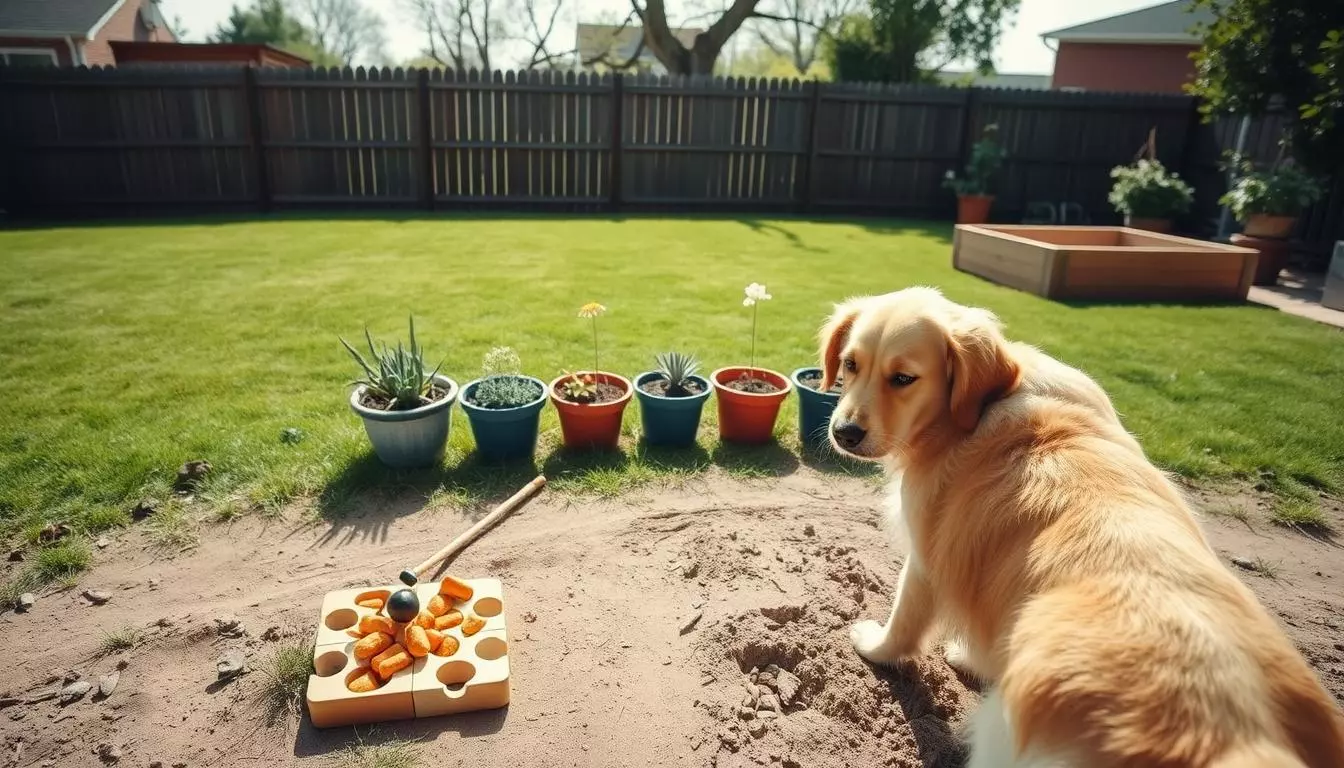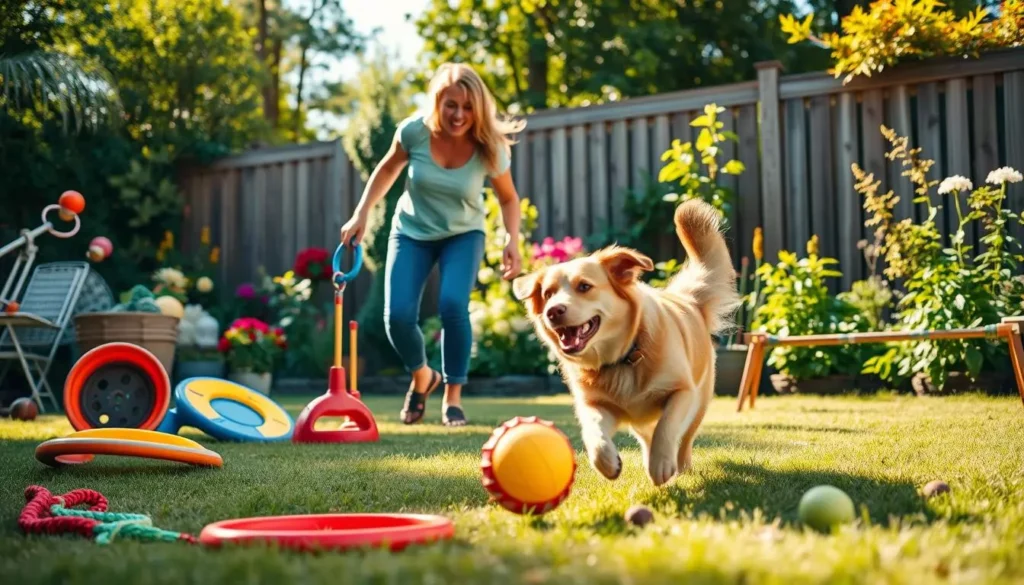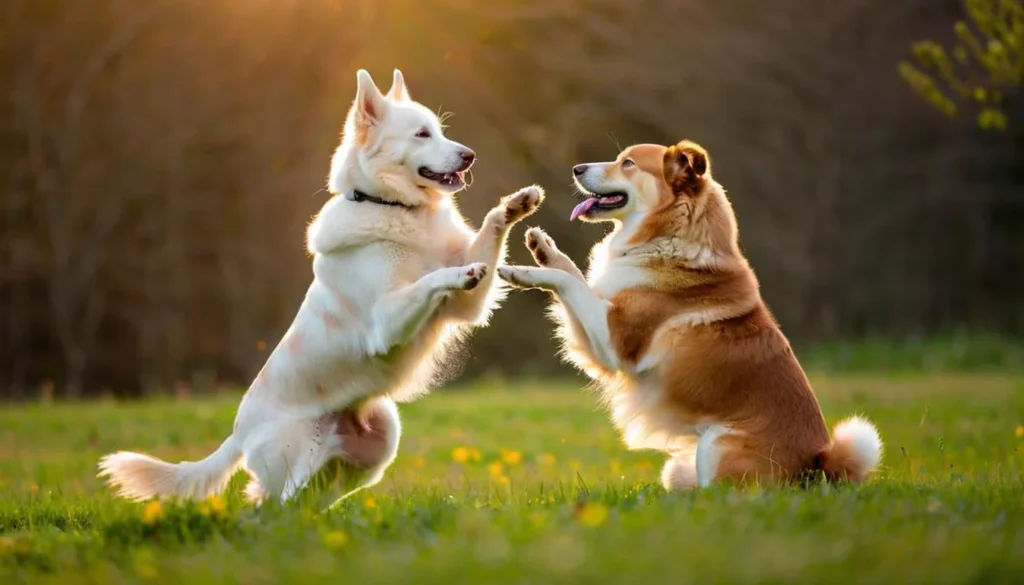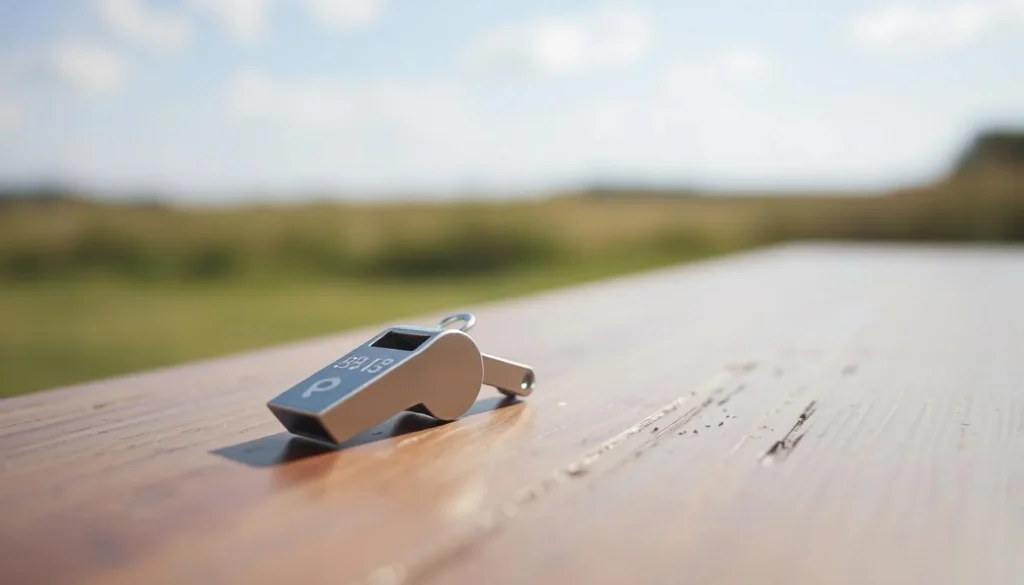As a devoted dog owner, I know the pain of finding holes in the yard. It feels like a battle between your garden and your dog's instincts. But, I've found that stopping this behavior isn't hard.
First, we need to understand why dogs dig. With the right approach, we can manage this problem. We can teach our dogs to play without digging up the yard.
This article aims to help you stop your dog from digging. We'll find ways to make our backyards safe for play. Let's work together to keep our yards beautiful and our dogs happy.
Key Takeaways
- Understanding the reasons behind your dog's digging behavior is essential.
- Implementing effective strategies can curb unwanted digging.
- Providing adequate exercise helps reduce the need to dig.
- Creating a designated digging zone may redirect their instincts positively.
- Seeking professional advice can lead to effective long-term solutions.
Understanding Dog Digging Behavior
Dog digging is a common behavior many pet owners face. It's often driven by instinct. Recognizing why our dogs dig is key to stopping them.
Boredom is a big reason dogs dig. If my dog isn't getting enough mental and physical activity, it digs. Extreme weather also prompts digging as a way to find comfort.
Watching my dog closely helps me understand why it digs. Knowing the triggers lets me create a plan to stop it. This improves our bond and reduces digging.
Why Does My Dog Dig Up the Yard?
Understanding why my dog digs up the yard is key to solving the problem. Dogs dig for many reasons, like instinct and environmental responses. Knowing these reasons helps me figure out how to stop them from digging.
Instinctual Reasons for Digging
Some dogs dig because of their breed's instincts. Terriers, for example, were bred to hunt underground animals. This instinct makes them want to dig, even in our yard. It's important to understand and redirect this behavior.
Digging as a Response to Weather
Dogs dig to find comfortable spots, especially in extreme weather. In hot weather, they dig for cooler soil. In cold weather, they dig to warm up. Providing shelter and cool spots helps reduce digging.
Hunting and Foraging Instincts
Dogs have a strong urge to hunt and forage. This urge leads them to dig for food or small animals. By understanding these instincts, I can find ways to keep them busy with toys or games.
How Can I Stop My Dog from Digging?
To stop my dog from digging, I need to find out why they do it. Dogs dig for many reasons, like boredom, anxiety, or instinct. Watching my dog closely helps me understand their digging habits. This way, I can find good ways to stop them.
Identifying the Triggers
First, I need to know what makes my dog dig. Some common reasons include:
- Boredom, which can lead to digging as a way to escape.
- Stress from changes or loud noises.
- The curiosity about underground creatures.
Knowing these reasons helps me find ways to stop my dog from digging. I can then focus on teaching them better behaviors.
Assessing Your Dog's Environment
Creating a space that doesn't encourage digging is also important. I should look at my dog's surroundings, such as:
- Do they have fun toys and activities for play?
- Is there enough shade for comfort in hot weather?
- Does my dog feel safe and relaxed at home?
By improving my dog's environment, I can help them enjoy the outdoors more. This makes it easier to keep them from digging.
Providing Adequate Exercise
Too much energy can make dogs dig. I've seen that enough exercise can really help. Daily walks and fun outdoor activities are good for their health and keep their minds active.
Daily Walks and Outdoor Activities
Daily walks help my dog use up energy. Outdoor activities add even more benefits. A fast walk or a run in the park is great.
Trying new places keeps things exciting. These habits are key to stopping dogs from digging.
Engaging Playtime Ideas
Playtime is crucial for managing digging. I use toys like balls and frisbees to keep my dog busy. Games like fetch or tug-of-war are fun and stimulating.
Creative play ideas can be very effective. They tire dogs out and keep them focused on other things.
Making Sure They Have a Way to Get Cool
As warmer weather comes, my dog digs to cool down. I understand this and take steps to keep her comfy. I provide shade and water, making a cool spot for her to escape the heat.
Creating Cool Areas in the Yard
Setting up cool spots in the yard helps a lot. I use umbrellas or trees for shade. An elevated dog bed or mat in the shade is perfect for her to rest.
These spots keep her cool and stop her from digging.
Providing Shade and Water
It's key to give my dog plenty of water and shade. A kiddie pool with fresh water is a fun way for her to cool off. Easy access to clean water all day helps her not dig for cooler spots.
| Features | Benefits |
|---|---|
| Shady Spots | Provides cool resting areas, discouraging digging |
| Elevated Dog Bed | Keeps my dog off the hot ground, promoting comfort |
| Kiddie Pool | Offers a fun way to cool off, reducing digging behavior |
| Fresh Water Supply | Ensures hydration, lessening the need to dig |
Keeping Your Dog Entertained
Dogs dig holes when they're bored. To stop this, it's key to keep them busy. I use fun activities to keep my dog from digging.
Interactive Toys and Activities
Interactive toys like treat balls and puzzle toys keep my dog engaged for hours. They solve problems and get rewards, which keeps them entertained. Changing these toys often keeps them excited and interested.
Offering Variety in Playtime
It's important to mix up playtime. I take my dog on different walks and play fetch in new spots. Playing games like hide-and-seek or scent tracking keeps their mind sharp and strengthens our bond. This variety keeps my dog happy and helps prevent digging.

Adding Digging Deterrents
To stop your dog from digging holes, using deterrents is key. Adding these makes some areas less appealing to your dog. This approach helps without using punishment. It keeps your garden safe and beautiful.
Using Natural Deterrents
Natural deterrents are a smart choice. They keep your dog away without harming them. Cayenne pepper, vinegar, and citrus peels work well. Sprinkle them where your dog likes to dig.
These items make the area uninviting. They help keep your dog safe and active.
Physical Barriers in the Yard
Physical barriers are also effective. Chicken wire, large rocks, or thorny bushes block digging spots. They act as a visual and physical stop.
By placing these barriers, you make your yard safe. Your dog can play without digging up your garden.
Establishing a Designated Digging Zone
Creating a special digging area for dogs can manage their natural digging urges. This method helps control digging and lets my dog enjoy digging without harming my garden.
Setting Up a Digging Area
Choose a spot in your yard that you don't mind being dug up. Fill it with loose soil or sand to make it inviting. Burying toys or treats in it makes it even more appealing.
This encourages my dog to dig in the right place. It's a great way to keep them from digging in unwanted areas.
Encouraging Positive Digging Behavior
When my dog digs in their zone, I praise them and give treats. This positive reinforcement makes them associate digging with rewards. It's a key step in stopping unwanted digging.
Using Professional Training Assistance
Getting help from a professional trainer can really help you and your dog. A good trainer will give you advice that fits your dog's special needs. Training at home is great because it lets your dog feel at ease while working on its digging problem.
The Benefits of In-Home Training
In-home training has many perks:
- Customized Approach: Trainers can look at your dog's home and behavior.
- Convenience: You don't have to travel, saving time and stress.
- Strengthening Bonds: A trainer can help you and your dog grow closer.
- Effective Solutions: They offer training that lasts and really works.
Choosing the Right Trainer
Finding the right trainer is key for good training. Think about these things when choosing:
- Do they have experience with digging behavior?
- Do they have the right certifications?
- Have other pet owners had good experiences with them?
- Do their training methods match what you want?
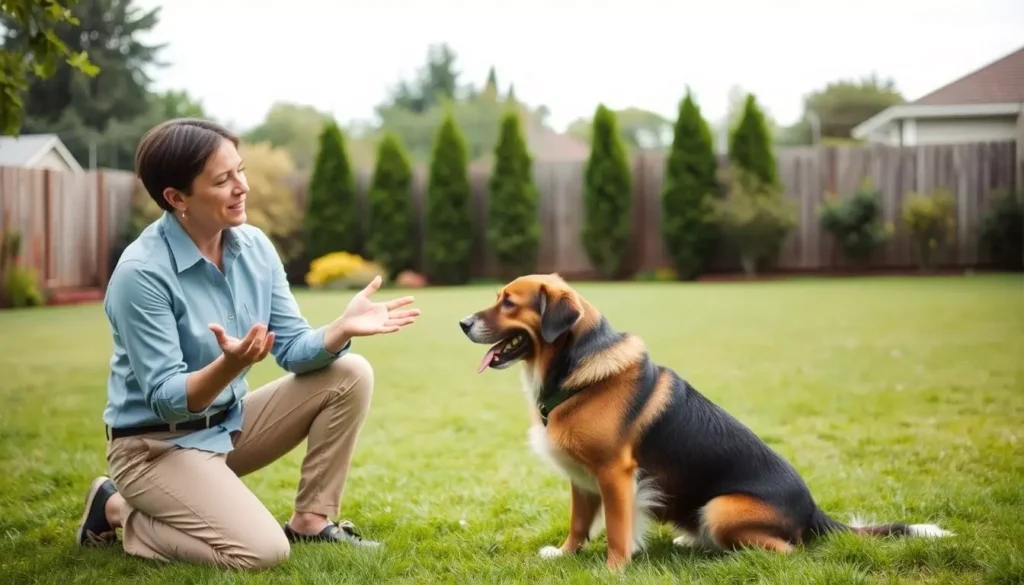
Addressing Potential Escape Behaviors
As a dog owner, I know how worried we get when our dogs escape. It's key to figure out why they want to get out. Dogs might dig out because they're lonely, bored, or distracted by their surroundings. Knowing what makes them want to escape helps us keep them safe.
Identifying Escape Triggers
Looking at my dog's world helps me see what makes them want to leave. Some common reasons include:
- Feeling lonely when they're alone for a long time.
- Being excited or upset by other animals or people.
- Seeking shelter or comfort in bad weather.
Implementing Safety Measures Around the Yard
To stop dogs from escaping, I've tried a few things. Here are some strategies that work:
- Burying chicken wire at the fence's base makes digging harder.
- Using big rocks or wooden barriers to strengthen the yard's edges.
- Checking the fence often for holes or weak spots to stop escapes.
Managing Boredom in Dogs
Keeping dogs happy and healthy is key. Dogs might dig when they're bored. To stop this, we need to keep them mentally active.
It's important to give dogs different activities. These should challenge their minds and keep them happy.
The Importance of Mental Stimulation
Mental stimulation is vital for a dog's well-being. Activities that make them think help prevent boredom. This leads to a happier life for them.
Activities to Keep Them Engaged
To keep my dog entertained, I try several things:
- Teaching new tricks or commands to enhance obedience and confidence.
- Participating in scent work, which taps into their natural hunting instincts.
- Introducing interactive games that encourage problem-solving, such as treat-dispensing puzzle toys.
Changing these activities often is important. It keeps my dog engaged and stops them from digging. With the right activities, we create a happy environment for them.
| Activity Type | Description | Benefits |
|---|---|---|
| Trick Training | Teaching commands like sit, stay, or roll over. | Improved obedience and mental challenge. |
| Scent Work | Incorporating games that focus on scent detection. | Taps into natural instincts and enhances focus. |
| Interactive Toys | Using puzzle toys that require manipulation to access treats. | Encourages problem-solving and reduces boredom. |
Understanding Your Dog’s Breed-Specific Traits
Understanding why dogs dig is linked to their breed traits. Each dog breed has unique characteristics that affect their digging habits. For example, some breeds were bred for digging, like hunting or burrowing.
Digging Predispositions in Certain Breeds
Some breeds are more prone to digging. Terriers, for instance, have a strong instinct to dig because of their hunting background. They are drawn to exploring underground dens. Working breeds, needing lots of exercise, might dig if they're bored.
Adjusting Training Based on Breed Behavior
Knowing these traits helps me tailor training. I can use strategies that fit their specific needs. For dogs that dig, I redirect their behavior to acceptable activities. This approach works better for them.
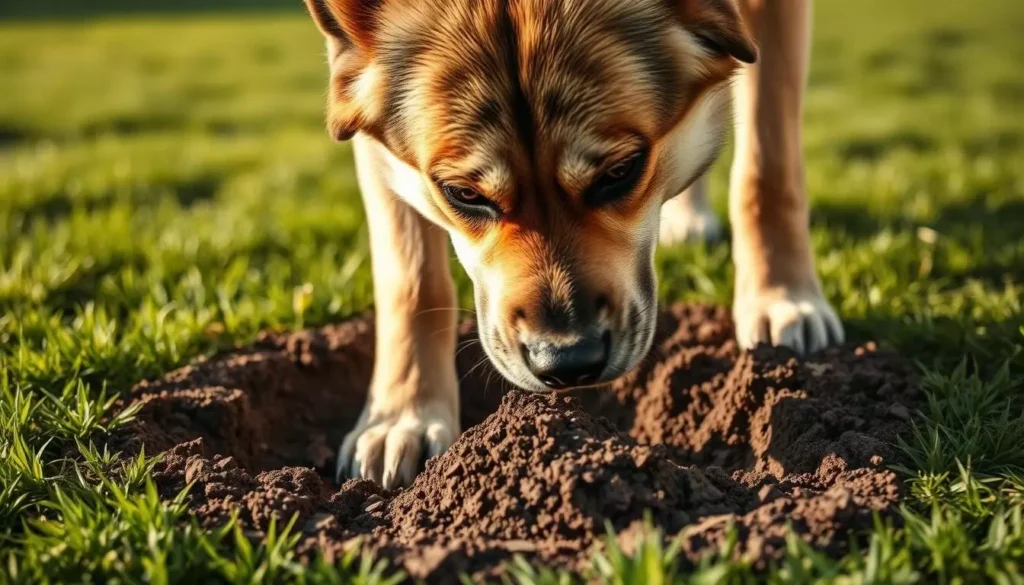
| Breed | Reason for Digging | Training Tips |
|---|---|---|
| Terrier | Instinctual hunting | Provide alternative activities |
| Labrador | Boredom and playfulness | Increase physical exercise |
| Beagle | Strong scent drive | Engage with scent games |
| German Shepherd | Working instincts | Focus on training and jobs |
By understanding my dog’s breed traits, I can create a better environment. This reduces unwanted digging and supports their natural abilities.
Recognizing Attention-Seeking Digging
As a dog owner, I've seen how dogs seek attention in many ways, like digging. Knowing why they dig helps me fix the problem. My dog digs to get my attention, whether it's positive or negative. Spotting this pattern is key to a peaceful home without digging.
Providing Quality Time and Attention
Spending quality time with dogs is crucial for a strong bond and their happiness. Setting aside time each day to play or cuddle helps. It makes our relationship better and cuts down on digging.
Redirecting Attention Appropriately
When my dog digs for attention, I redirect their behavior. I give them toys or teach new tricks. This keeps them busy and happy, reducing digging.
Eliminating Underground Creatures
Dog digging due to pests can be quite the challenge. Often, our furry friends dig in search of underground creatures such as moles, gophers, or other small animals. Understanding and identifying signs of pest activity can greatly assist in addressing this behavior and providing a more peaceful environment for both my dog and myself.
Identifying Signs of Pests
Recognizing the signs of pests is crucial for eliminating pests in the yard. Look for:
- Fresh dirt mounds or holes in the ground
- Distinctive tracks or trails near the affected area
- Chewing marks on plants or other vegetation
By paying close attention to these details, I can determine if my dog's digging behavior is motivated by the presence of unwanted critters.
Humane Ways to Remove Burrowing Animals
Implementing humane pest removal methods is a responsible approach to manage these underground creatures. I have found that a few effective strategies include:
- Using live traps to capture and relocate pests safely
- Utilizing natural repellents that deter burrowing animals without harming them
- Contacting local animal control services for professional assistance
By adopting these humane pest removal methods, I can not only help reduce my dog's desire to dig but also maintain a balanced ecosystem in my yard.
Creating a Comfortable Outdoor Environment
A comfy outdoor space is key for your dog's happiness and can stop them from digging. Make sure they have a cozy shelter, fresh water, and safe spots to relax and enjoy the outdoors.
Safe Shelter Solutions for Hot or Cold Conditions
Think about your dog's shelter needs. In the heat, a shaded spot is a must. I use big umbrellas or trees for shade. A kiddie pool is great for cooling off.
In the cold, they need a warm place. I use insulated dog houses or heated spots for them to escape the chill.
The Importance of Fresh Water
Water is vital for your dog's health. Always have a clean water bowl out for them. On hot days or after play, make sure they have plenty of water.
Use spill-proof bowls to keep things tidy and make sure they can drink easily.
| Weather Condition | Recommended Shelter Solutions | Water Provisions |
|---|---|---|
| Hot Weather | Shade from trees or umbrellas, kiddie pool | Multiple bowls with fresh water, cooling mats |
| Cold Weather | Insulated dog house, blankets | Check water for freezing, heated water bowls |
Preventing Destructive Digging Behavior
Understanding why dogs dig can help stop them in your yard. Dogs dig for many reasons, like instinct, boredom, or comfort. Knowing why they dig helps me find the right solutions.
Understanding the Psychology of Digging
Digging is a natural instinct for many dogs. Breeds like terriers were made for hunting underground animals. Knowing this helps me understand and manage their digging.
Instead of scolding them, I create a special digging spot. This way, they can dig without causing trouble.
Alternatives to Punishment
Positive reinforcement is key in changing digging habits. When my dog digs in the right spot, I reward them. This encourages them to dig where they should.
Praising them for playing in their area or giving them toys helps. This approach not only stops bad digging but also strengthens our bond.
Conclusion
Dog digging is a common issue for many pet owners. I've found that understanding why my dog digs is key. It could be for instinct, boredom, or to escape.
By figuring out the reasons, I've been able to find the right solutions. This has helped me manage my dog's digging behavior.
Prevention and redirection are essential in keeping my yard safe. I make sure my dog gets enough exercise and has a place to dig. Using fun toys also helps.
This approach keeps my yard looking great and my dog happy. If you're dealing with dog digging, these tips can help. They'll improve your relationship with your dog.

